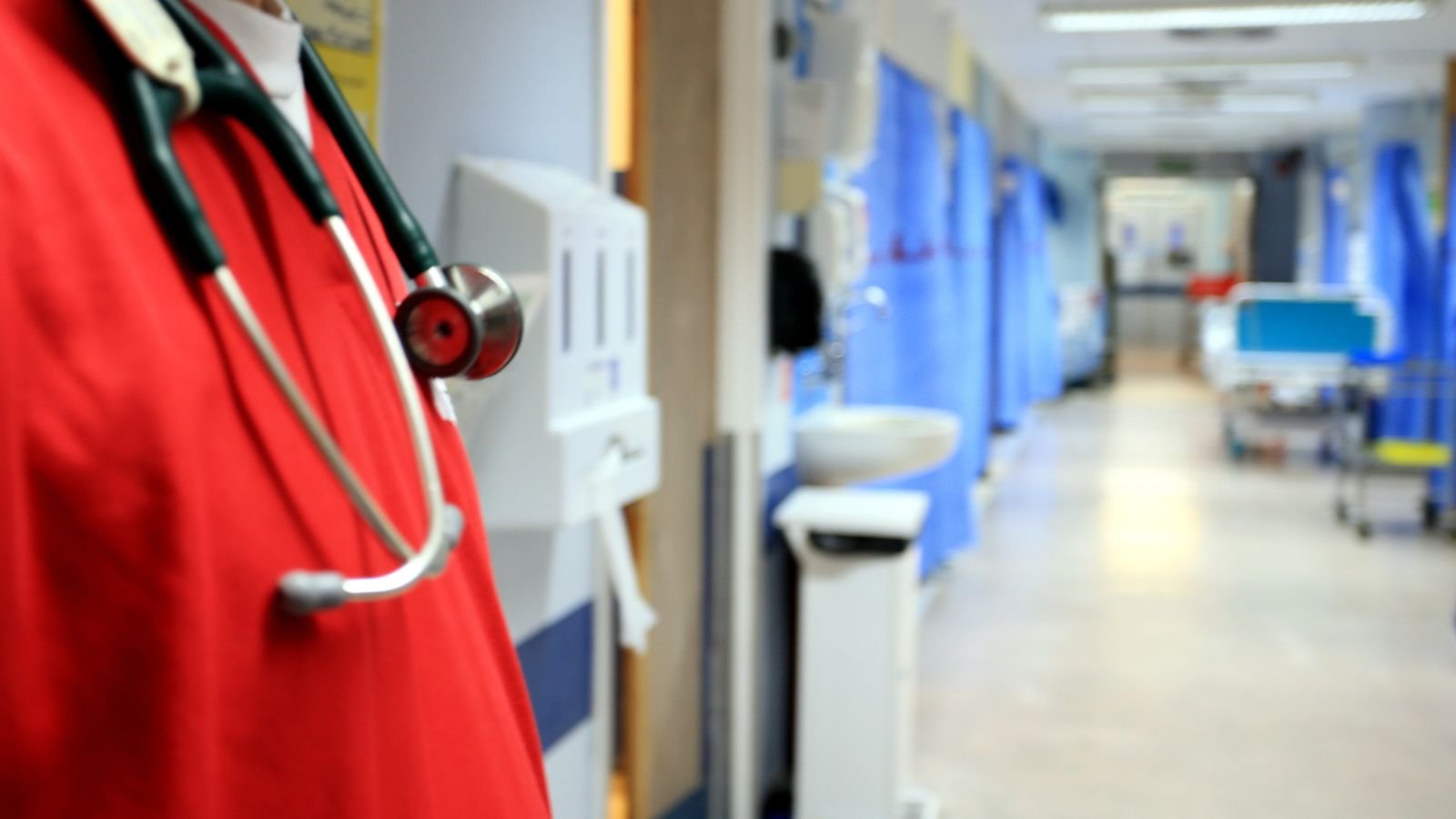Tools & Platforms
NHS to use AI technology to help free up hospital beds | UK News

Artificial Intelligence (AI) technology is being piloted to help free up NHS hospital beds being used by people who are fit to be sent home, officials have said.
A new platform, currently being trialled by Chelsea and Westminster NHS Trust, uses AI to help fill out the documents needed to discharge a patient – potentially saving hours of delays.
The tool extracts information such as diagnoses and test results from medical records, helping staff to draft discharge summaries, which must be completed before a person is sent home from the hospital.
The document is then reviewed by healthcare professionals responsible for the patient and used to send them home or refer them to other services.
Health Secretary Wes Streeting has said the technology will allow doctors to spend less time on paperwork and more time on patient care, cutting waiting times in the process.
The tool will be hosted on the NHS Federated Data Platform (FDP), a shared software system designed to make it easier for health and care organisations to work together and provide better services.
The current manual system can leave patients waiting for hours to be discharged as doctors may be too busy to fill in forms, according to the Department for Science, Innovation and Technology.
Mr Streeting said: “This potentially transformational discharge tool is a prime example of how we’re shifting from analogue to digital as part of our 10-year health plan.
“We’re using cutting-edge technology to build an NHS fit for the future and tackle the hospital backlogs that have left too many people waiting too long.”
👉Listen to Politics at Sam and Anne’s on your podcast app👈
The platform is one of a number of projects backed by Sir Keir Starmer, who in January said that AI would be used to “turn around” the economy and public services.
In May, the government announced it was rolling out an AI tool to test public feeling on different issues, which it said could save around £20m in staffing.
It has also been announced that technology shown to halve the time probation officers spend organising notes will be rolled out nationwide this year.
Tools & Platforms
Your browser is not supported
usatoday.com wants to ensure the best experience for all of our readers, so we built our site to take advantage of the latest technology, making it faster and easier to use.
Unfortunately, your browser is not supported. Please download one of these browsers for the best experience on usatoday.com
Tools & Platforms
iShares Future AI & Tech ETF (NYSEARCA:ARTY) Surges 27.6% in 2025 — Is It a Buy?

ARTY delivers strong tech exposure with 83% allocation to AI leaders, but volatility and valuations test investor conviction | That’s TradingNEWS
8/30/2025 8:54:36 PM
Tools & Platforms
Emperor Musk’s AI Clothes – Will Lockett’s Newsletter

Musk has been parading around in his AI clothes for a while now. With the amount he screams and shouts about AI, you’d think he invented it. Of course, like everything else Musk peddles, he had nothing to do with its invention or development, except for underpaying and overworking his engineers and being an awful, overpromising PR man. However, people aren’t just noticing that Musk’s clothes are non-existent — they are also starting to point and laugh at his skid marks and the “I Love the Nazi Man” tattoo down his back. Why? Because he just can’t seem to get his AI up and working. And there is no little blue pill to remedy this situation.
Take, for example, Tesla’s hilariously crap Robotaxi rollout. The media at large is only just cottoning on to it being a huge PR stunt.
I have gone on ad nauseam about why Tesla’s self-driving cars are completely inadequate, so if you want to know the details, read my previous article here. But the helicopter view is that, unlike other autonomous vehicles, Tesla’s system has zero redundancy or safety nets and requires a nearly 100% accurate AI — which categorically can’t exist — to be even remotely safe.
Tesla is painfully aware of this fatal flaw, with Tesla engineers whistleblowing their concerns about it to the media (read more here) and the DOJ opening an investigation (read more here). So I, along with countless other commentators, was pretty damn relieved to find out that Tesla’s Robotaxis had safety drivers. There was even mention of remote workers being able to take control of the car and drive it safely in the case of a critical disengagement.
But this kind of system isn’t impressive enough for Musk. Any Uber or Lyft driver with a Tesla who wastes their money on FSD can do the exact same thing. There is no social or investor kudos to be gained for Tesla or Musk here. And here is a hint: Musk doesn’t make money from Tesla sales. After all, his $50 billion pay packet (which is now less, thanks to Musk tanking Tesla’s valuation) was the equivalent of him getting $10,000 for every Tesla ever sold! Tesla makes substantially less profit from every car sold than that.
So, what do you do if you have bet your entire company’s valuation on autonomous technology that you simply can’t deliver on?
Fudge it.
Tesla put the safety driver in the passenger seat! Because, look, it’s a self-driving car — there is no one in the driver’s seat!
This is a dangerous move that offers no benefit other than optics.
Rather than being able to properly take over the car and drive it to safety, the only thing these safety drivers could do was press a button to bring the vehicle to a stop. Which, as anyone with a driving licence will tell you, is not always the safest option! Particularly when you consider that Robotaxis have been spotted driving into lanes of oncoming traffic.
Yet, this bafflingly shite decision wasn’t really reported on. Or at least it wasn’t until a video surfaced a few days ago that showed FSD failing and a safety driver being forced to exit the vehicle in the middle of traffic to take the driver’s seat and regain control. (watch it here).
This shows just how wildly dangerous Tesla’s Robotaxis are.
The safety driver had to take a serious risk to take control of the car. Not only that, but this incident suggests there are no remote operatives capable of taking over when things go wrong. That has been a core safety feature of all developing self-driving ride-hailing services, such as Waymo and Cruise, since day one and is routinely used to keep passengers safe. The fact that this is absent for Robotaxis, which Tesla already know have a far, far higher critical disengagement rate than any other self-driving ride-hailing service, could easily be seen as insanely negligent.
Musk is comfortable putting other people — not just the safety driver, but paying passengers and the public — in danger, all for a crappy PR stunt to cover up how bad his self-driving system actually is. And the media at large, as well as public consensus, are beginning to catch up to this horrifying fact.
However, Musk’s AI woes go far, far deeper than that.
-
Tools & Platforms3 weeks ago
Building Trust in Military AI Starts with Opening the Black Box – War on the Rocks
-

 Ethics & Policy1 month ago
Ethics & Policy1 month agoSDAIA Supports Saudi Arabia’s Leadership in Shaping Global AI Ethics, Policy, and Research – وكالة الأنباء السعودية
-

 Events & Conferences3 months ago
Events & Conferences3 months agoJourney to 1000 models: Scaling Instagram’s recommendation system
-

 Jobs & Careers2 months ago
Jobs & Careers2 months agoMumbai-based Perplexity Alternative Has 60k+ Users Without Funding
-

 Funding & Business2 months ago
Funding & Business2 months agoKayak and Expedia race to build AI travel agents that turn social posts into itineraries
-

 Business1 day ago
Business1 day agoThe Guardian view on Trump and the Fed: independence is no substitute for accountability | Editorial
-

 Education2 months ago
Education2 months agoVEX Robotics launches AI-powered classroom robotics system
-

 Podcasts & Talks2 months ago
Podcasts & Talks2 months agoHappy 4th of July! 🎆 Made with Veo 3 in Gemini
-

 Podcasts & Talks2 months ago
Podcasts & Talks2 months agoOpenAI 🤝 @teamganassi
-

 Jobs & Careers2 months ago
Jobs & Careers2 months agoAstrophel Aerospace Raises ₹6.84 Crore to Build Reusable Launch Vehicle

